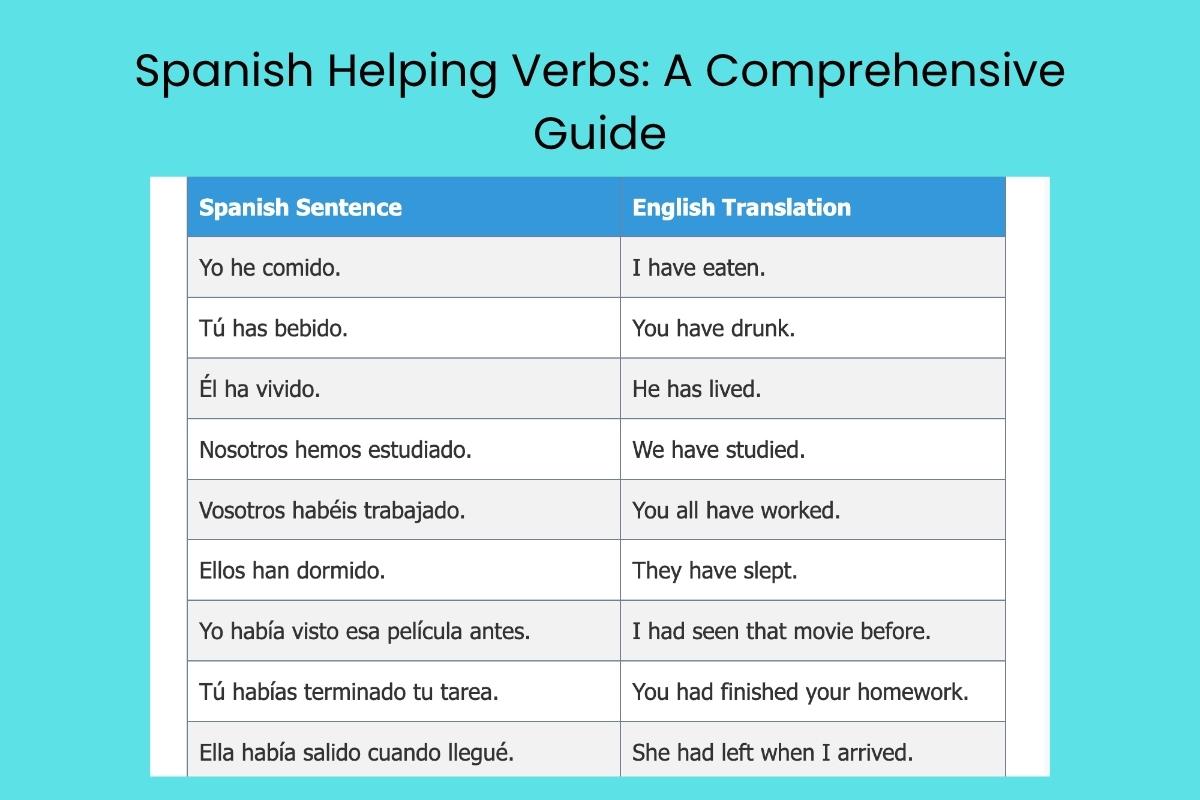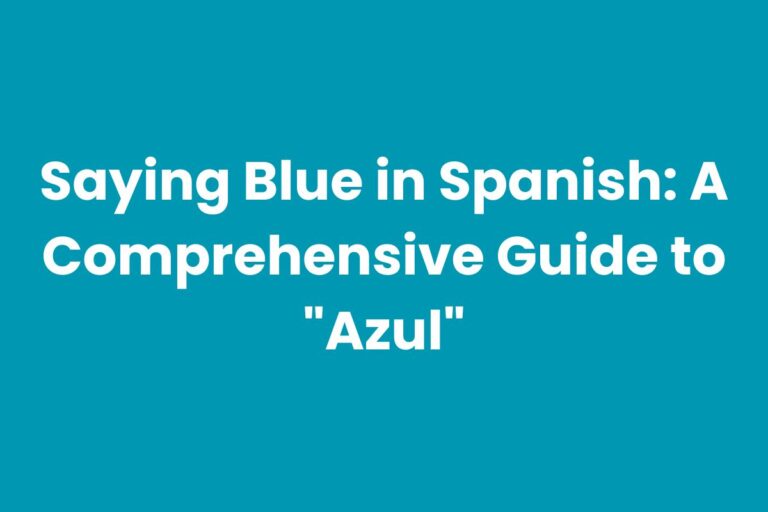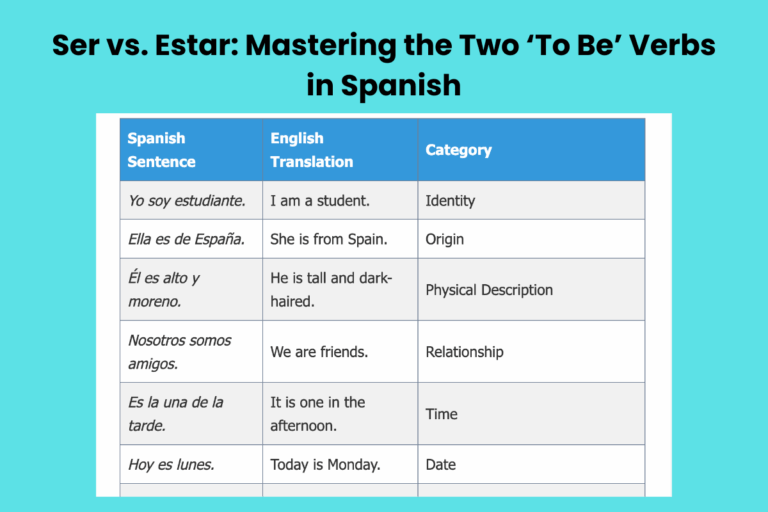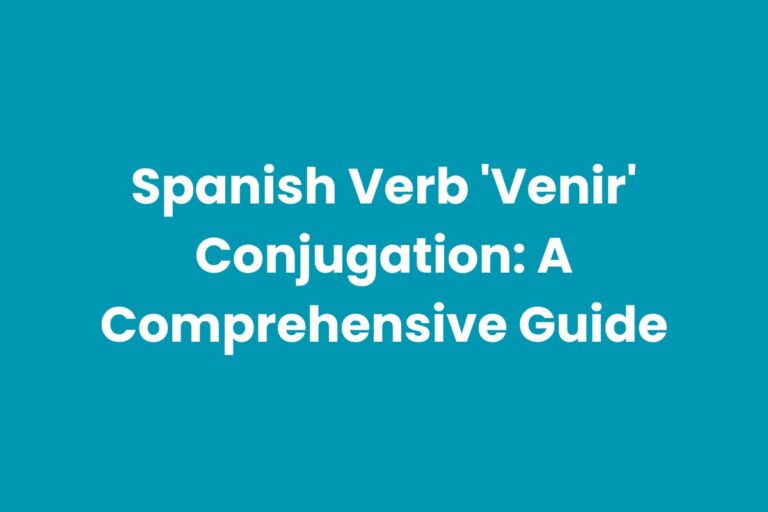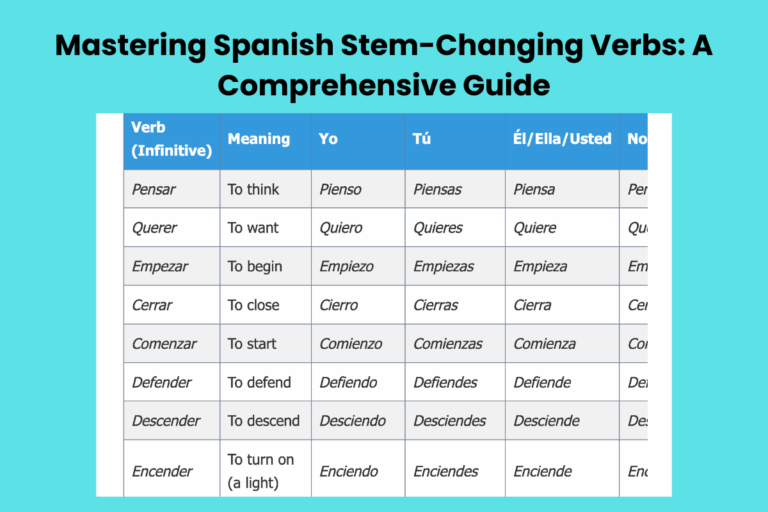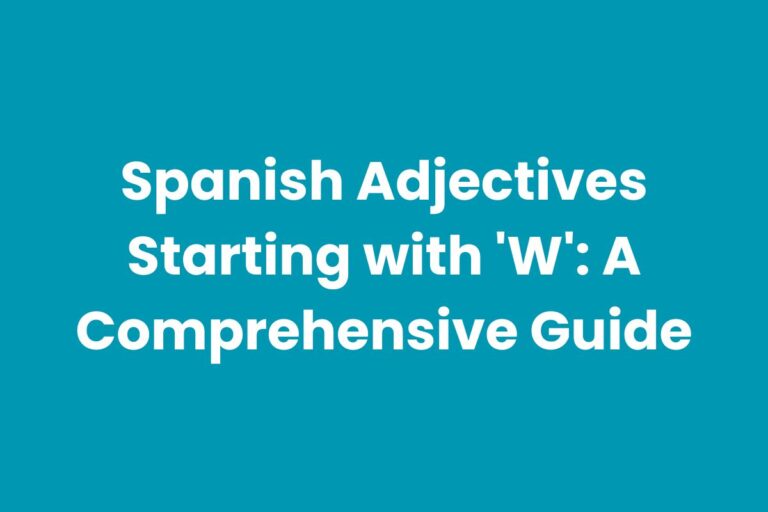Spanish Helping Verbs: A Comprehensive Guide
Mastering Spanish involves understanding how verbs work, and a crucial component of this is the use of helping verbs (also known as auxiliary verbs). These verbs combine with main verbs to express tense, mood, and voice, adding nuances to your sentences.
This guide provides a detailed exploration of Spanish helping verbs, their functions, and how to use them correctly. Whether you’re a beginner or an advanced learner, understanding these verbs will significantly improve your fluency and accuracy in Spanish.
This comprehensive resource covers everything from basic definitions to advanced usage, ensuring a solid foundation for your language learning journey.
Table of Contents
- Introduction
- Definition of Helping Verbs in Spanish
- Structural Breakdown
- Types and Categories of Helping Verbs
- Examples of Helping Verbs in Spanish
- Usage Rules
- Common Mistakes
- Practice Exercises
- Advanced Topics
- FAQ
- Conclusion
Definition of Helping Verbs in Spanish
Helping verbs, or auxiliary verbs, are verbs that precede the main verb in a sentence to provide grammatical information, such as tense, mood, or voice. In Spanish, these verbs don’t carry the primary meaning but help to modify or specify the meaning of the main verb.
They work in tandem with the main verb to create compound tenses, passive voice constructions, or express modality (possibility, obligation, etc.). Understanding their function is crucial for constructing grammatically correct and nuanced sentences.
Helping verbs in Spanish are essential for forming compound tenses like the perfect tenses (e.g., he comido – I have eaten), progressive tenses (e.g., estoy comiendo – I am eating), and passive voice constructions (e.g., fue escrito – it was written). They also play a significant role in expressing modal meanings using verbs like poder (can), deber (should), and tener que (have to). Mastering these verbs allows learners to express a wide range of ideas and communicate more effectively in Spanish.
Structural Breakdown
The structure involving helping verbs in Spanish typically follows a pattern where the helping verb is conjugated according to the subject, and the main verb appears in a non-finite form (infinitive, participle, or gerund). This structure allows for the expression of various tenses, moods, and aspects.
Let’s break down the common structures:
- Helping Verb + Infinitive: This structure is used with modal verbs like poder, deber, querer, and verbs like ir a to express future actions. Example: Puedo cantar (I can sing).
- Helping Verb + Past Participle: This structure is used to form perfect tenses using the helping verb haber. Example: He comido (I have eaten).
- Helping Verb + Gerund: This structure is used to form progressive tenses, typically using the helping verb estar. Example: Estoy comiendo (I am eating).
- Ser/Estar + Past Participle: This is used to form the passive voice. Example: La carta fue escrita (The letter was written).
The placement of pronouns can also affect the structure. When using pronouns with verb phrases that include an infinitive or gerund, the pronoun can either precede the helping verb or be attached to the infinitive or gerund. For example, “I want to see it” can be translated as Lo quiero ver or Quiero verlo. The choice often depends on regional preferences and personal style, but both forms are generally acceptable.
Types and Categories of Helping Verbs
Haber (to have)
Haber is the primary helping verb used to form perfect tenses in Spanish. When combined with a past participle, it indicates that an action has been completed. The conjugation of haber changes according to the subject, while the past participle remains constant.
For example, to say “I have eaten,” you would use he comido, where he is the conjugated form of haber for “yo” (I), and comido is the past participle of comer (to eat). This construction is essential for expressing actions that occurred before a specific point in time.
Ser and Estar (to be)
Both ser and estar translate to “to be,” but they are used in different contexts. Ser is used to describe permanent or inherent qualities, while estar is used for temporary states or conditions. As helping verbs, they are crucial in forming the passive voice and progressive tenses, respectively.
When used in the passive voice (e.g., La casa fue construida – The house was built), either ser or estar can be the helping verb, depending on whether you want to emphasize the action or the resulting state. Estar is also the primary helping verb for forming the present progressive tense (e.g., Estoy leyendo – I am reading), indicating an action in progress.
Ir a (to go to)
Ir a followed by an infinitive is used to express the near future tense in Spanish. It’s equivalent to “going to” in English. The verb ir is conjugated according to the subject, and the infinitive remains unchanged.
For instance, Voy a comer means “I am going to eat.” This construction is commonly used to express plans or intentions for the immediate future. It’s a simple and versatile way to talk about what you will do soon.
Deber (should/must)
Deber is a modal verb that expresses obligation or probability. When followed by an infinitive, it indicates what someone should do or what is likely to happen. The conjugation of deber changes according to the subject, and the infinitive remains unchanged.
For example, Debes estudiar means “You should study.” This verb is often used to give advice or express expectations. It conveys a sense of duty or recommendation.
Poder (can/to be able to)
Poder is a modal verb that expresses ability or possibility. When followed by an infinitive, it indicates what someone is capable of doing or what is likely to happen. The conjugation of poder changes according to the subject, and the infinitive remains unchanged.
For example, Puedo nadar means “I can swim.” This verb is frequently used to express skills or potential actions. It conveys a sense of capability or permission.
Tener que (to have to)
Tener que followed by an infinitive expresses obligation or necessity. It’s equivalent to “have to” in English. The verb tener is conjugated according to the subject, and que is followed by the infinitive.
For instance, Tengo que trabajar means “I have to work.” This construction is commonly used to express duties or requirements. It’s a direct way to indicate what must be done.
Estar + Gerundio (Present Progressive)
Estar combined with a gerund (the -ing form of a verb in English) forms the present progressive tense. This tense describes actions that are currently in progress. The verb estar is conjugated according to the subject, and the gerund is formed by adding -ando to -ar verbs and -iendo to -er and -ir verbs.
For example, Estoy hablando means “I am speaking.” This construction is used to describe actions happening at the moment of speaking. It conveys a sense of immediacy and ongoing activity.
Examples of Helping Verbs in Spanish
This section provides extensive examples of helping verbs in Spanish, categorized by the specific helping verb used. Each table offers a variety of sentences to illustrate the usage and context of these verbs.
Examples with Haber (to have)
The following table shows examples of haber used in various perfect tenses. The perfect tenses are used to describe actions that have been completed at some point in the past.
| Spanish Sentence | English Translation |
|---|---|
| Yo he comido. | I have eaten. |
| Tú has bebido. | You have drunk. |
| Él ha vivido. | He has lived. |
| Nosotros hemos estudiado. | We have studied. |
| Vosotros habéis trabajado. | You all have worked. |
| Ellos han dormido. | They have slept. |
| Yo había visto esa película antes. | I had seen that movie before. |
| Tú habías terminado tu tarea. | You had finished your homework. |
| Ella había salido cuando llegué. | She had left when I arrived. |
| Nosotros habíamos visitado París. | We had visited Paris. |
| Vosotros habíais comido todo el pastel. | You all had eaten all the cake. |
| Ellos habían cerrado la tienda. | They had closed the store. |
| Yo habré terminado para mañana. | I will have finished by tomorrow. |
| Tú habrás recibido el paquete. | You will have received the package. |
| Él habrá llegado a casa. | He will have arrived home. |
| Nosotros habremos aprendido español. | We will have learned Spanish. |
| Vosotros habréis viajado por el mundo. | You all will have traveled the world. |
| Ellos habrán construido la casa. | They will have built the house. |
| Si hubiera sabido, te habría llamado. | If I had known, I would have called you. |
| Si tú hubieras estudiado, habrías aprobado. | If you had studied, you would have passed. |
| Si él hubiera tenido dinero, habría viajado. | If he had had money, he would have traveled. |
| Si nosotros hubiéramos llegado temprano, habríamos visto el espectáculo. | If we had arrived early, we would have seen the show. |
| Si vosotros hubierais practicado, habríais ganado. | If you all had practiced, you would have won. |
| Si ellos hubieran sabido la verdad, habrían actuado diferente. | If they had known the truth, they would have acted differently. |
| Hubiera deseado haberte conocido antes. | I wish I had met you before. |
| Hubieras debido llegar más temprano. | You should have arrived earlier. |
| Ella hubiera querido ir a la fiesta. | She would have wanted to go to the party. |
| Nosotros hubiéramos podido ayudarte. | We could have helped you. |
Examples with Ser and Estar (to be)
The following table illustrates the use of ser and estar as helping verbs, particularly in the passive voice and with adjectives.
| Spanish Sentence | English Translation |
|---|---|
| La casa fue construida en 1950. | The house was built in 1950. |
| El libro es escrito por un autor famoso. | The book is written by a famous author. |
| La puerta está abierta. | The door is open. |
| La comida está preparada. | The food is prepared. |
| El problema fue resuelto. | The problem was solved. |
| Las ventanas están cerradas. | The windows are closed. |
| La carta fue enviada ayer. | The letter was sent yesterday. |
| El pastel está horneado. | The cake is baked. |
| La lección es aprendida. | The lesson is learned. |
| Los platos están lavados. | The dishes are washed. |
| La canción fue cantada por ella. | The song was sung by her. |
| El coche está arreglado. | The car is fixed. |
| La tarea fue revisada. | The homework was reviewed. |
| El jardín está cuidado. | The garden is taken care of. |
| La película fue vista por muchos. | The movie was seen by many. |
| Las luces están apagadas. | The lights are off. |
| El documento fue firmado. | The document was signed. |
| El agua está hervida. | The water is boiled. |
| La verdad es dicha. | The truth is told. |
| Los árboles están plantados. | The trees are planted. |
| La respuesta fue encontrada. | The answer was found. |
| Los regalos están envueltos. | The gifts are wrapped. |
| El café fue preparado. | The coffee was prepared. |
| Las flores están regadas. | The flowers are watered. |
| El examen fue aprobado. | The exam was passed. |
| Las sillas están organizadas. | The chairs are organized. |
Examples with Ir a (to go to)
The following table provides examples of ir a used to express the near future. This construction is very common in Spanish to talk about plans and intentions.
| Spanish Sentence | English Translation |
|---|---|
| Voy a comer ahora. | I am going to eat now. |
| Vas a estudiar mañana. | You are going to study tomorrow. |
| Él va a viajar a España. | He is going to travel to Spain. |
| Nosotros vamos a ver una película. | We are going to watch a movie. |
| Vosotros vais a salir esta noche. | You all are going to go out tonight. |
| Ellos van a comprar un coche nuevo. | They are going to buy a new car. |
| Voy a leer un libro. | I am going to read a book. |
| Vas a aprender español. | You are going to learn Spanish. |
| Ella va a cantar en el concierto. | She is going to sing at the concert. |
| Nosotros vamos a bailar salsa. | We are going to dance salsa. |
| Vosotros vais a cocinar la cena. | You all are going to cook dinner. |
| Ellos van a jugar al fútbol. | They are going to play soccer. |
| Voy a escribir una carta. | I am going to write a letter. |
| Vas a visitar a tus abuelos. | You are going to visit your grandparents. |
| Él va a trabajar en la oficina. | He is going to work at the office. |
| Nosotros vamos a limpiar la casa. | We are going to clean the house. |
| Vosotros vais a comprar ropa nueva. | You all are going to buy new clothes. |
| Ellos van a plantar árboles. | They are going to plant trees. |
| Voy a llamar a mi madre. | I am going to call my mother. |
| Vas a hacer ejercicio. | You are going to exercise. |
| Él va a estudiar medicina. | He is going to study medicine. |
| Nosotros vamos a celebrar el cumpleaños. | We are going to celebrate the birthday. |
| Vosotros vais a asistir a la reunión. | You all are going to attend the meeting. |
| Ellos van a vender su casa. | They are going to sell their house. |
Examples with Deber (should/must)
The following table illustrates the use of deber to express obligation or probability. This modal verb adds a layer of meaning to the main verb, indicating what is expected or likely.
| Spanish Sentence | English Translation |
|---|---|
| Debo estudiar más. | I should study more. |
| Debes comer verduras. | You should eat vegetables. |
| Él debe llegar pronto. | He should arrive soon. |
| Nosotros debemos ayudar a los demás. | We should help others. |
| Vosotros debéis ser honestos. | You all should be honest. |
| Ellos deben respetar las reglas. | They should respect the rules. |
| Debo hacer ejercicio. | I should exercise. |
| Debes beber agua. | You should drink water. |
| Ella debe dormir ocho horas. | She should sleep eight hours. |
| Nosotros debemos cuidar el planeta. | We should take care of the planet. |
| Vosotros debéis ser puntuales. | You all should be punctual. |
| Ellos deben pagar sus impuestos. | They should pay their taxes. |
| Debo leer más libros. | I should read more books. |
| Debes escribir tus pensamientos. | You should write your thoughts. |
| Él debe visitar a sus padres. | He should visit his parents. |
| Nosotros debemos aprender un nuevo idioma. | We should learn a new language. |
| Vosotros debéis viajar más. | You all should travel more. |
| Ellos deben ahorrar dinero. | They should save money. |
| Debo llamar a mi amigo. | I should call my friend. |
| Debes hacer la tarea. | You should do the homework. |
| Ella debe ir al médico. | She should go to the doctor. |
| Nosotros debemos ser amables. | We should be kind. |
| Vosotros debéis limpiar vuestra habitación. | You all should clean your room. |
| Ellos deben escuchar a sus profesores. | They should listen to their teachers. |
Examples with Poder (can/to be able to)
The following table provides examples of poder used to express ability or possibility. This modal verb is essential for indicating what someone is capable of doing or what is likely to happen.
| Spanish Sentence | English Translation |
|---|---|
| Puedo hablar español. | I can speak Spanish. |
| Puedes nadar muy bien. | You can swim very well. |
| Él puede tocar la guitarra. | He can play the guitar. |
| Nosotros podemos ayudarte. | We can help you. |
| Vosotros podéis venir mañana. | You all can come tomorrow. |
| Ellos pueden resolver el problema. | They can solve the problem. |
| Puedo cocinar la cena. | I can cook dinner. |
| Puedes leer este libro. | You can read this book. |
| Ella puede cantar muy bien. | She can sing very well. |
| Nosotros podemos bailar salsa. | We can dance salsa. |
| Vosotros podéis escribir un poema. | You all can write a poem. |
| Ellos pueden jugar al fútbol. | They can play soccer. |
| Puedo escribir una carta. | I can write a letter. |
| Puedes visitar a tus abuelos. | You can visit your grandparents. |
| Él puede trabajar en la oficina. | He can work at the office. |
| Nosotros podemos limpiar la casa. | We can clean the house. |
| Vosotros podéis comprar ropa nueva. | You all can buy new clothes. |
| Ellos pueden plantar árboles. | They can plant trees. |
| Puedo llamar a mi madre. | I can call my mother. |
| Puedes hacer ejercicio. | You can exercise. |
| Él puede estudiar medicina. | He can study medicine. |
| Nosotros podemos celebrar el cumpleaños. | We can celebrate the birthday. |
| Vosotros podéis asistir a la reunión. | You all can attend the meeting. |
| Ellos pueden vender su casa. | They can sell their house. |
Examples with Tener que (to have to)
The following table provides examples of tener que used to express obligation or necessity. This construction is essential for indicating duties or requirements.
| Spanish Sentence | English Translation |
|---|---|
| Tengo que trabajar hoy. | I have to work today. |
| Tienes que estudiar para el examen. | You have to study for the exam. |
| Él tiene que ir al médico. | He has to go to the doctor. |
| Nosotros tenemos que limpiar la casa. | We have to clean the house. |
| Vosotros tenéis que pagar la cuenta. | You all have to pay the bill. |
| Ellos tienen que levantarse temprano. | They have to get up early. |
| Tengo que cocinar la cena. | I have to cook dinner. |
| Tienes que leer este libro. | You have to read this book. |
| Ella tiene que cantar en el concierto. | She has to sing at the concert. |
| Nosotros tenemos que bailar salsa. | We have to dance salsa. |
| Vosotros tenéis que escribir un poema. | You all have to write a poem. |
| Ellos tienen que jugar al fútbol. | They have to play soccer. |
| Tengo que escribir una carta. | I have to write a letter. |
| Tienes que visitar a tus abuelos. | You have to visit your grandparents. |
| Él tiene que trabajar en la oficina. | He has to work at the office. |
| Nosotros tenemos que limpiar la casa. | We have to clean the house. |
| Vosotros tenéis que comprar ropa nueva. | You all have to buy new clothes. |
| Ellos tienen que plantar árboles. | They have to plant trees. |
| Tengo que llamar a mi madre. | I have to call my mother. |
| Tienes que hacer ejercicio. | You have to exercise. |
| Él tiene que estudiar medicina. | He has to study medicine. |
| Nosotros tenemos que celebrar el cumpleaños. | We have to celebrate the birthday. |
| Vosotros tenéis que asistir a la reunión. | You all have to attend the meeting. |
| Ellos tienen que vender su casa. | They have to sell their house. |
Examples with Estar + Gerundio (Present Progressive)
The following table provides examples of estar used with the gerund to form the present progressive tense. This tense is used to describe actions that are currently in progress.
| Spanish Sentence | English Translation |
|---|---|
| Estoy comiendo. | I am eating. |
| Estás bebiendo. | You are drinking. |
| Él está viviendo. | He is living. |
| Nosotros estamos estudiando. | We are studying. |
| Vosotros estáis trabajando. | You all are working. |
| Ellos están durmiendo. | They are sleeping. |
| Estoy leyendo un libro. | I am reading a book. |
| Estás aprendiendo español. | You are learning Spanish. |
| Ella está cantando una canción. | She is singing a song. |
| Nosotros estamos bailando salsa. | We are dancing salsa. |
| Vosotros estáis cocinando la cena. | You all are cooking dinner. |
| Ellos están jugando al fútbol. | They are playing soccer. |
| Estoy escribiendo una carta. | I am writing a letter. |
| Estás visitando a tus abuelos. | You are visiting your grandparents. |
| Él está trabajando en la oficina. | He is working at the office. |
| Nosotros estamos limpiando la casa. | We are cleaning the house. |
| Vosotros estáis comprando ropa nueva. | You all are buying new clothes. |
| Ellos están plantando árboles. | They are planting trees. |
| Estoy llamando a mi madre. | I am calling my mother. |
| Estás haciendo ejercicio. | You are exercising. |
| Él está estudiando medicina. | He is studying medicine. |
| Nosotros estamos celebrando el cumpleaños. | We are celebrating the birthday. |
| Vosotros estáis asistiendo a la reunión. | You all are attending the meeting. |
| Ellos están vendiendo su casa. | They are selling their house. |
Usage Rules
The correct usage of helping verbs in Spanish involves understanding several key rules. These rules govern how helping verbs combine with main verbs to form different tenses, moods, and voices.
Paying attention to these rules will help you construct grammatically accurate and meaningful sentences.
- Agreement: The helping verb must agree with the subject in number and person. This means the conjugation of the helping verb changes depending on who is performing the action. For example, Yo he comido (I have eaten), Él ha comido (He has eaten).
- Infinitive Usage: When a helping verb is followed by an infinitive, the infinitive remains unchanged. This is common with modal verbs like poder, deber, and querer. For example, Quiero comer (I want to eat).
- Past Participle Agreement: In compound tenses formed with haber, the past participle does not change to agree with the subject. However, in passive voice constructions with ser or estar, the past participle must agree in gender and number with the subject. For example, La casa fue construida (The house was built – feminine singular), Los libros fueron escritos (The books were written – masculine plural).
- Pronoun Placement: When using pronouns with verb phrases that include an infinitive or gerund, the pronoun can either precede the helping verb or be attached to the infinitive or gerund. For example, Lo quiero ver or Quiero verlo (I want to see it).
- Progressive Tense: The present progressive tense is formed using estar + gerund. The gerund is formed by adding -ando to -ar verbs and -iendo to -er and -ir verbs. For example, Estoy hablando (I am speaking), Estamos comiendo (We are eating).
Common Mistakes
Even experienced learners often make mistakes with helping verbs. Being aware of these common errors can help you avoid them and improve your accuracy.
- Incorrect Verb Agreement: Failing to conjugate the helping verb correctly to match the subject.
- Incorrect: Yo ha comido. Correct: Yo he comido.
- Incorrect: Ellos es estudiando. Correct:
Ellos están estudiando.
- Misusing Ser and Estar: Using ser when estar is required, or vice versa.
- Incorrect: Estoy alto. (Intending to say “I am tall,” a permanent characteristic) Correct: Soy alto.
- Incorrect: Soy cansado. (Intending to say “I am tired,” a temporary condition) Correct: Estoy cansado.
- Incorrect Past Participle Agreement: Not making the past participle agree in gender and number with the subject in passive voice constructions.
- Incorrect: La puerta fue abierto. Correct: La puerta fue abierta.
- Incorrect: Los libros están escrito. Correct: Los libros están escritos.
- Wrong Gerund Formation: Incorrectly forming the gerund in progressive tenses.
- Incorrect: Estoy comiendoiendo. Correct: Estoy comiendo.
- Incorrect: Está hablandoando. Correct: Está hablando.
- Forgetting the Preposition “a” with Ir a: Omitting the “a” when expressing the near future.
- Incorrect: Voy comer. Correct: Voy a comer.
- Incorrect: Vamos estudiar. Correct: Vamos a estudiar.
Practice Exercises
Test your understanding of helping verbs with these practice exercises. Fill in the blanks with the correct form of the helping verb.
Advanced Topics
For advanced learners, there are several nuances and complex constructions involving helping verbs that can further enhance your understanding and fluency.
- Subjunctive Mood: The subjunctive mood often requires specific helping verbs to express doubt, desire, or uncertainty. For example, “Es necesario que hayas terminado” (It is necessary that you have finished).
- Conditional Tenses: Conditional tenses use helping verbs to express hypothetical situations. For example, “Habría ido si hubiera tenido tiempo” (I would have gone if I had had time).
- Perfect Subjunctive: This tense combines haber in the subjunctive with a past participle to express actions that have been completed before a certain point in the past within a subjunctive context. For example, “Dudo que él haya llegado tarde” (I doubt that he has arrived late).
- Passive Voice with Ser vs. Estar: The choice between ser and estar in passive constructions can subtly change the meaning. Ser emphasizes the action, while estar emphasizes the resulting state. For example, “El libro fue escrito por él” (The book was written by him – action), “El libro está escrito en español” (The book is written in Spanish – state).
FAQ
Conclusion
Mastering helping verbs is essential for achieving fluency and accuracy in Spanish. These verbs are the building blocks of complex tenses, moods, and voices, allowing you to express a wide range of ideas and communicate effectively.
By understanding the different types of helping verbs, their usage rules, and common mistakes to avoid, you can significantly improve your Spanish language skills. Continue to practice and explore advanced topics to further refine your understanding and fluency.
Happy learning!

